Your cart is currently empty!

Beginner’s Guide to Downhill Skiing with Kids
Downhill skiing is a super fun and active winter activity for the whole family. Skiing is also a sport that kids can start learning at a very young age. Today, Sarah Warburton, mom of two raising her daughters in the Alps, is here today with all you need to know to get started downhill skiing with kids. She’s sharing her knowledge and experience teaching kids to ski, with all you need to know about what to pack, how to find the best kid-friendly resort, how to choose the right ski gear, tips for teaching kids, and so much more!
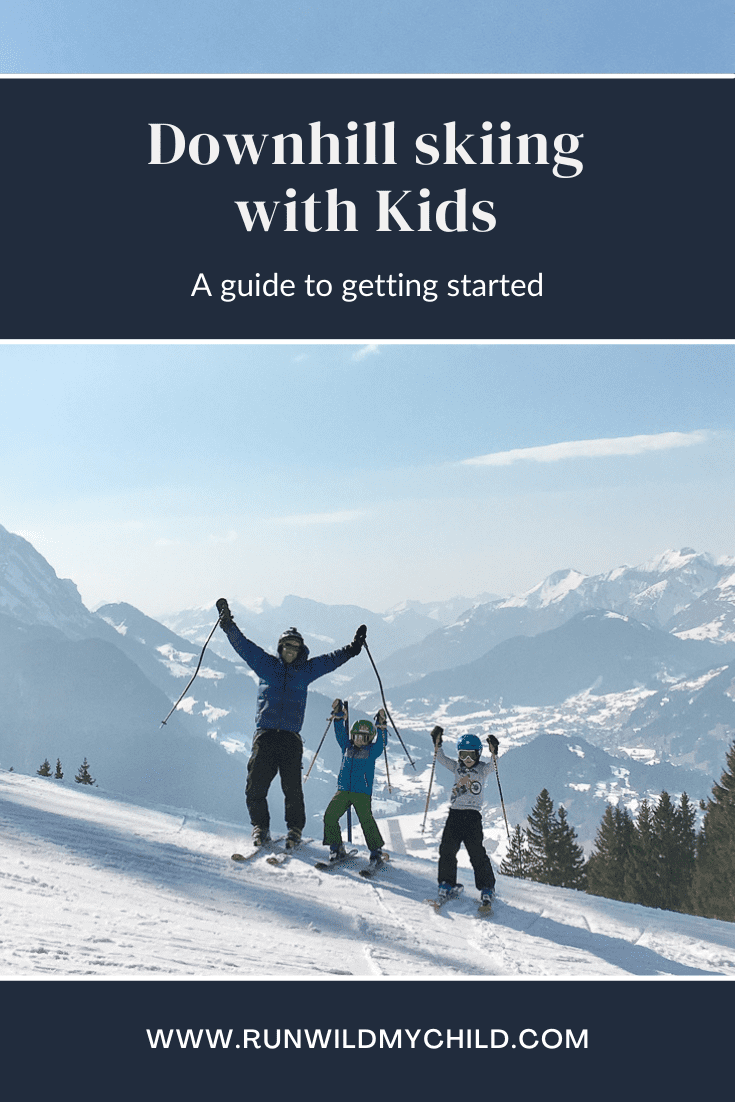
Winter is ski season
When the days get shorter and the temperatures drop, it can be hard to motivate even the most active of kids to get outside. We’ve found that sometimes the best way to get outside in the cold is to find something you really enjoy doing and can look forward to. So, for our family, those blustery, cold, dreary, days at the end of the year have a silver lining – IT’S SNOWING IN THE MOUNTAINS! We have found an activity that everyone in our family loves to do in the winter. So now, every year, our family looks forward excitedly to the first snow and the promise of the ski season ahead!
Benefits of downhill skiing for kids
There are so many amazing benefits of skiing for both kids and adults. Aside from being the perfect excuse to spend the day outside, skiing allows you to access beautiful places you would never otherwise get to see. It’s also great for improving balance and coordination. Even little kids can quickly feel empowered as they navigate moving at (relative!) speed down the mountain. Once the basics have been mastered the whole mountain really does become a playground.
Skiing increases your child’s body and spatial awareness. While skiing, your child must be aware of what each part of their body is doing, as well as where they are positioned on the slopes in relation to others. Skiing improves strength, coordination, and balance. If you’ve skied before you know how strong your legs and core need to be for all those turns and stops. Skiing can also teach your child perseverance and foster a sense of confidence and healthy competition.
Downhill skiing with kids also brings the whole family together in a way that few other outdoor activities can. Skiing is an activity that can be enjoyed for a lifetime. Often the kids’ grandparents join us for the day and all three generations ski together. We alternate skiing with frequent stops to grab a snack, treat ourselves to a hot chocolate or admire the view.
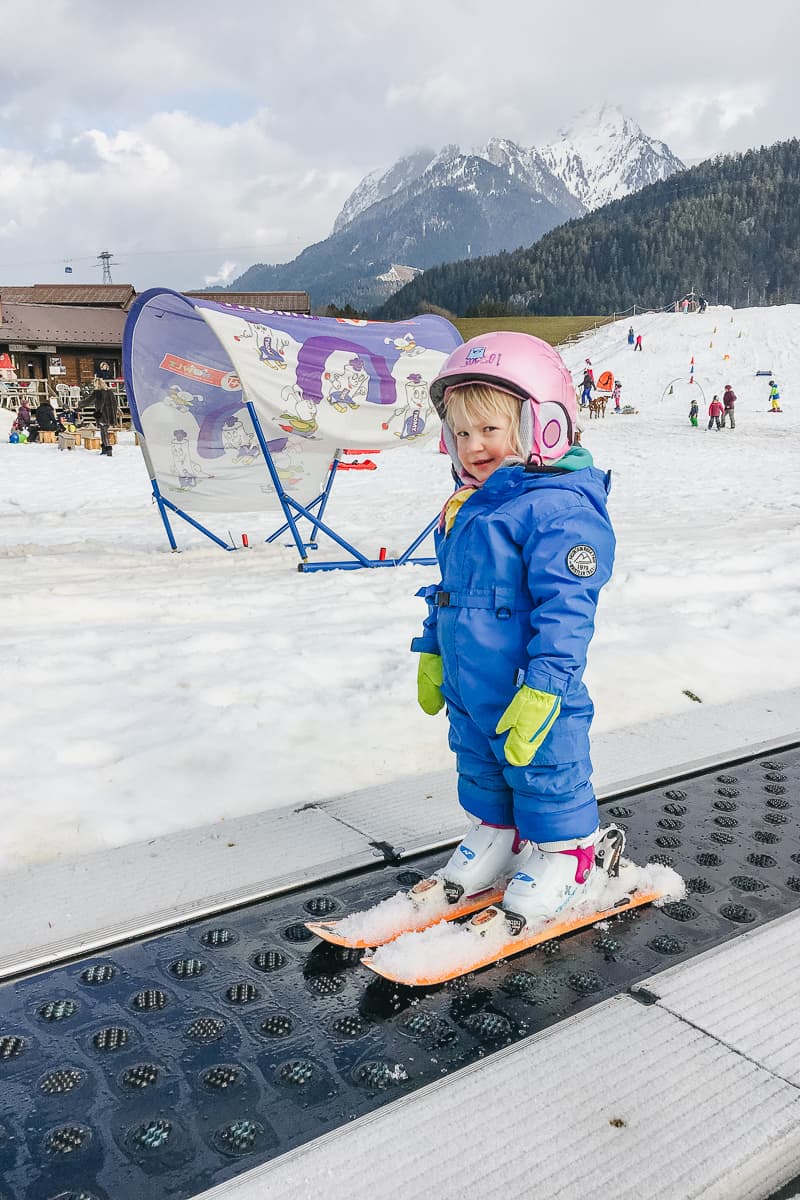
An introduction to downhill skiing with kids
Whether you’re a skier yourself or skiing is something that you’d love for your family to try, here is all you need to know to get your kids started downhill skiing! Today, I’ll walk you through the basics of how to get started skiing with kids, the best age for kids to start skiing, what to wear on the slopes, the low-down on renting or buying ski gear, tips on choosing a beginner ski resort, whether ski lessons are worth it, tips for skiing with a beginner, and so much more!
So, lace up your snow boots, and let’s get to it!
Have fun (and keep your expectations low)
Before we get into the logistics and technical skills of skiing with kids, it’s important start with your mindset and expectations. Remember that although you want your kids to learn to downhill ski, this should NOT be the goal for their first few times on the mountain. First and foremost, the goal when first learning to ski should be to have FUN! So, get rid of any expectations right now, arm yourself with a solid dose of patience, pack your sense of humor, and make the experience as entertaining as possible!
If your child is very small then they will probably just want to play in the snow at first. Once kitted out, they’ll also need some time to get used to the gear. Walking in ski boots can be a challenge! On skis, games will be your friend – Simon Says, Follow the Leader, imagining they are a super hero… there are a myriad of ways to get kids moving!
The best age for kids to start downhill skiing
What is the best age for a child to start learning to ski?
The short answer is ANY AGE! There’s no real “magic age” that’s perfect for kids to start learning to ski. Kids can start skiing at nearly any age (so don’t worry, you haven’t missed anything).
Kids as young as 2 years old can have fun on a very gentle slope but they are unlikely to join you on a real piste any time soon. At 2, 3, or 4 years old, most kids will enjoy play-based activities on skis. They may well learn to turn and stop by themselves, but they will be far from ready to hit the slopes. However, this early practice will greatly pay off, as they’ll have the benefit of knowing how to move in skills and are used to wearing ski boots.
From the age of 5 onwards, kids will learn skiing skills more quickly. It wouldn’t be unreasonable to expect them to handle an easy slope after a couple of days of practice. Fortunately, kids this age have very little fear of falling (and they’re low to the ground, so falls aren’t as hard on them), and so they make progress FAST!
Know your child’s personality and abilities
However, when learning any new sport or activity, a lot also depends on the child’s personality. Not every kid progresses the same. Not every 5-year-old will be ready to start skiing and not every 3 year-old will only want to play games in the snow. A lot will depend on your child’s personal comfort (ski gear can be bulky/heavy and may be tough for kids with sensory issues), your child’s athletic abilities (skiing takes a lot of leg and core strength), and their confidence/perseverance (learning to ski takes a lot of time and kids fall a lot – it can get frustrating).
Again, just remember that skiing should be FUN. Follow your child’s lead when it comes to what they are comfortable doing.
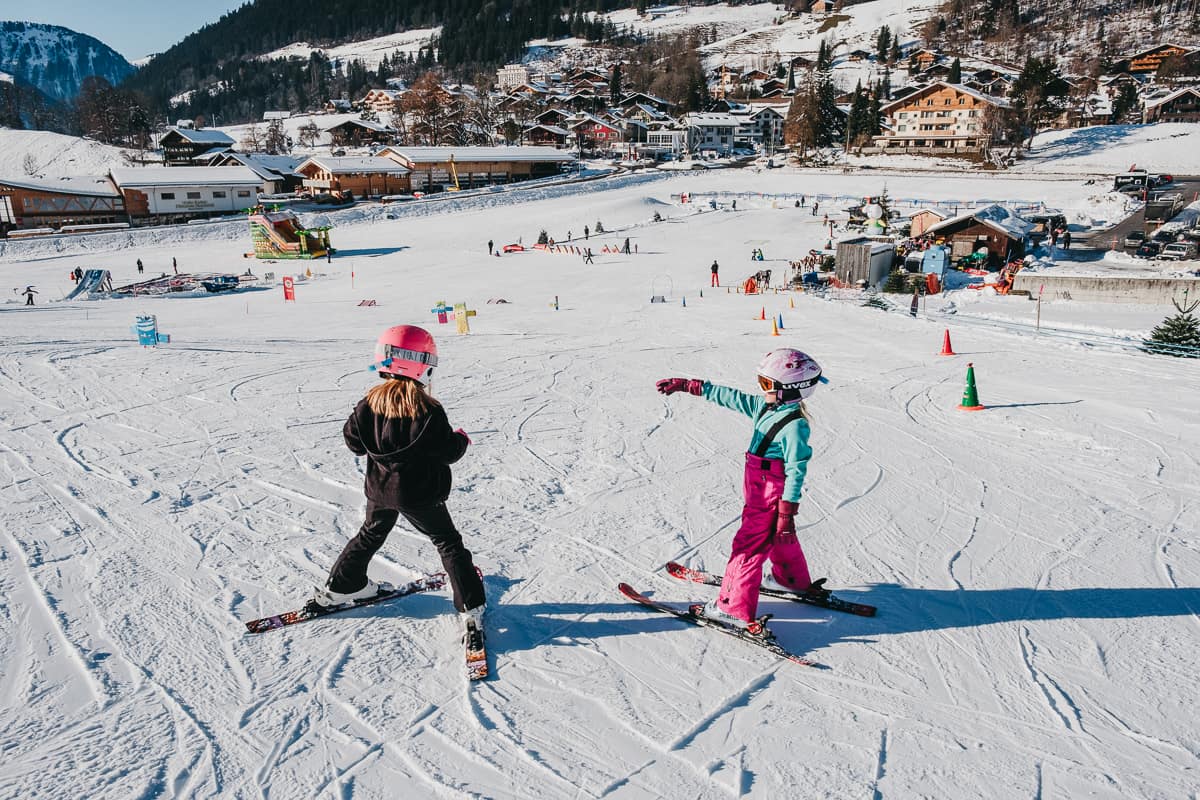
Downhill skiing with kids: what should kids wear?
Getting the family kitted out for skiing can feel daunting. There are a LOT of pieces and layers and items. And while the outdoor industry might want you to believe you have to have special “ski-specific gear” for downhill skiing, that’s not necessarily the case. If you have young kids and have already spent time outside in the snow then you probably have most of what you need. Simply put, children need to stay WARM and DRY. And that can be done in any good winter gear, whether it was made for skiing or not.
Layering for downhill skiing
The biggest tip for dressing kids when downhill skiing is to LAYER. When skiing with kids, you’ll need to be prepared for all weather, as conditions in the mountains can change quickly. The easiest way to be extra prepared is with layering. Your kids may need to add (or remove) a layer here and there to stay warm or cool off. Thin layers are your friend as they can be taken off or added as required.
So, from the first layer to the last, here’s what you will need to outfit your kids for downhill skiing:
- Long thermal underwear: Opt for a merino wool or a synthetic fabric baser layer, as these are more breathable and quicker drying than cotton-mix fabrics. Choose a long-sleeved top and long bottoms. Make sure they are comfortable (some kids can be very sensitive to itchiness – perhaps snip out any tags) and make sure they’re not too tight. For more info on wool layers, check out our article on The Best Merino Wool Base Layers for Kids and Toddlers.
- A warm, insulating layer: This might be a fleece or a synthetic top. Avoid cotton or anything too bulky. This layer will get taken on and off the most, so a full-length zip makes this easier. Avoid a hooded top that adds unnecessary bulk behind the neck.
- Warm socks: Socks for skiing need to come well above the top of the ski boot and should be a mixture of wool and synthetic fibers. Having two pairs of warm socks is useful. If your kids are like mine, socks are notorious for disappearing or getting soaked! It’s always handy to have a spare pair.
- Snow pants: Insulated pants that are reliably waterproof and breathable are a must for skiing. Ski pants will have a gaiter around the bottom to stop snow coming up the inside of the leg. Most children’s pants will come with straps to hold them up, but bibs are even better as they also come up high enough to stop snow from getting in at the waist. All-in-one snowsuits are another option that are great for keeping kids warm and dry. But beware…if your child is in nappies, potty training or might need to unexpectedly pee at the side of the piste, they are not very practical!
- Ski jacket: Like the pants, the material for your winter coat (your outer layers) needs to be waterproof but breathable. Choose an insulated jacket for warmth.
- Gloves/ mittens: Mittens are warmer than gloves for little fingers, so opt for these with younger kids. I like ones that come well up the arm and can be secured with a bungee cord. This is easier than tucking the mittens inside the sleeve of the jacket. Mittens are often the first thing to get wet, and wet/ cold hands = game over. If you can, keep a spare pair in your backpack or dry them out if you’re somewhere inside for lunch. For recommendations, check our Gear Review on the Best Kids Gloves and Mittens.
- Neck warmer: This keeps cold air and snow from going down the neck. This can be a scarf or (even better), a neck gaiter. It can be pulled up over the nose if it’s windy and cold. My kids prefer the thinner ones – a synthetic material or merino wool is best as it dries quickly (because, you know, snot).
- Helmet: Wearing a helmet when skiing is a non-negotiable! Helmets can be rented, or if you’d prefer to buy one, then you’ll probably get at least 2 seasons out of it. Most are adjustable and can worn a few years.
- Goggles: Children’s goggles are generally inexpensive and likely to last a few seasons too. Make sure that they fit snugly around the face and work with the helmet that you have.
Budget-friendly ski gear
Dedicated ski clothing is worn for just a few months of the year. Children grow quickly, so it can feel overwhelming purchasing nice ski gear that you know they’ll grow out of within a season or two. While we highly recommend good-quality gear, we don’t want your gear to break the bank or prevent you from getting outside.
Because kids usually grow out of winter gear before they wear it out, great quality items can be found on second-hand marketplaces. There are so many ways to get great gear and clothing second-hand now. With lots of different sales sites and apps like Poshmark, ThredUp, and Mercari, it’s easier than ever. You can even look locally using Facebook marketplace or search your local consignment or thrift shop. If you know other families that ski (maybe with kids of different ages than yours), you can also host a clothing swap with your friends and neighbors!
When looking for budget-friendly ski equipment and gear, shopping second-hand can save you a lot of money. If you live in a mountainous (ski-friendly) area, ski clubs, rental shops and rec departments often host ski swaps and used ski gear sales in the fall. This is a great place to buy used ski equipment. Decathlon is a great place to buy new but inexpensive good-quality gear. Other options for finding great deals on used ski gear are Facebook marketplace, eBay, Craigslist, and other used gear shops.
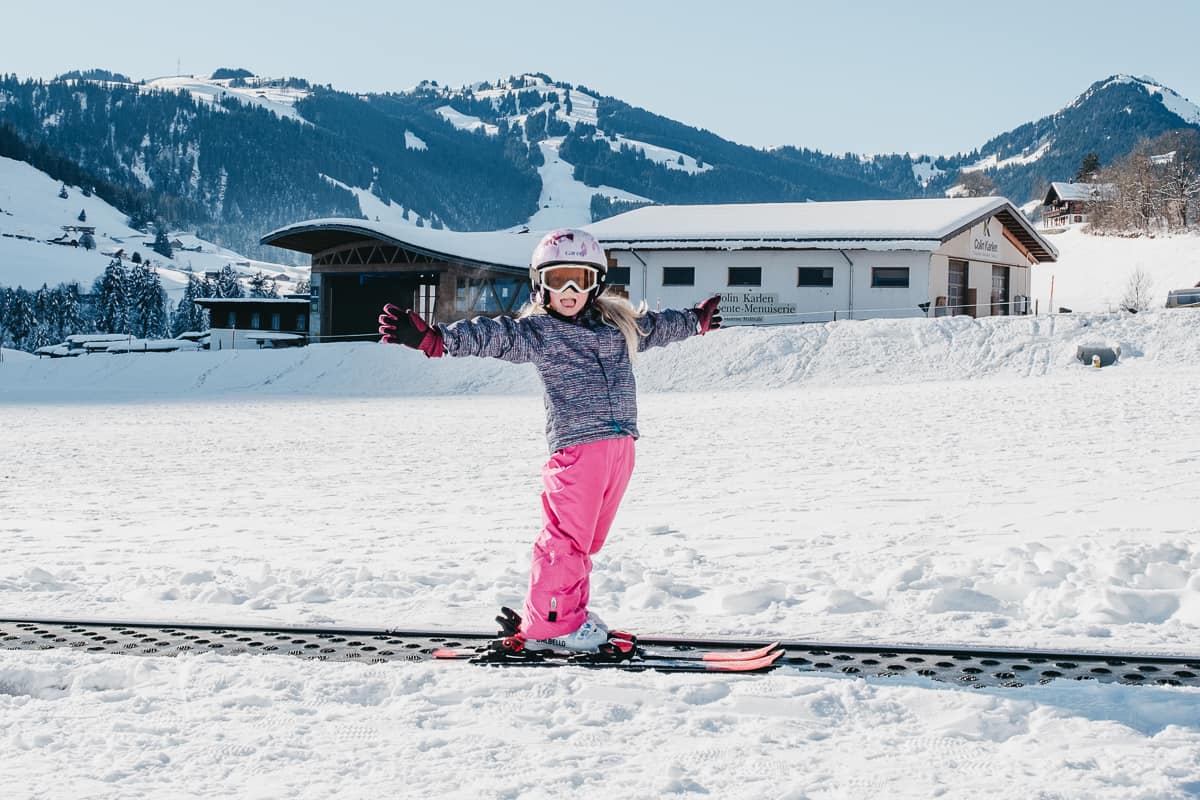
Kid’s ski equipment – should you rent or buy?
While the decision to rent or buy ski gear is a personal one, you might want to consider how much skiing you’ll be doing before making a big purchase. Young children grow quickly and so are unlikely to use the same size boots or possibly skis for more than one season. And ski equipment can be very expensive, depending on the quality and brand you choose. If it’s your first time skiing, I highly recommend you rent or even borrow ski gear to see if skiing is something you’ll continue doing.
We live in Switzerland and ski the entire winter. For this reason, we have always rented equipment in the early years. If you’ll be skiing regularly throughout the winter, you can rent/lease gear for the whole season. We ski a lot over the course of a winter, so this makes financial sense for us. Renting for individual days can quickly get expensive quickly, but might be the best option if you’ll only be skiing a few days out of the year. Rental equipment is usually reasonably priced and can be fitted each time for your child as they grow, ensuring proper fit.
Buying skis or boots new or second-hand if you know that you’ll be skiing regularly in a season or then passing them on to a younger sibling (or reselling them) is also a cost-effective option and may be the best thing for you.
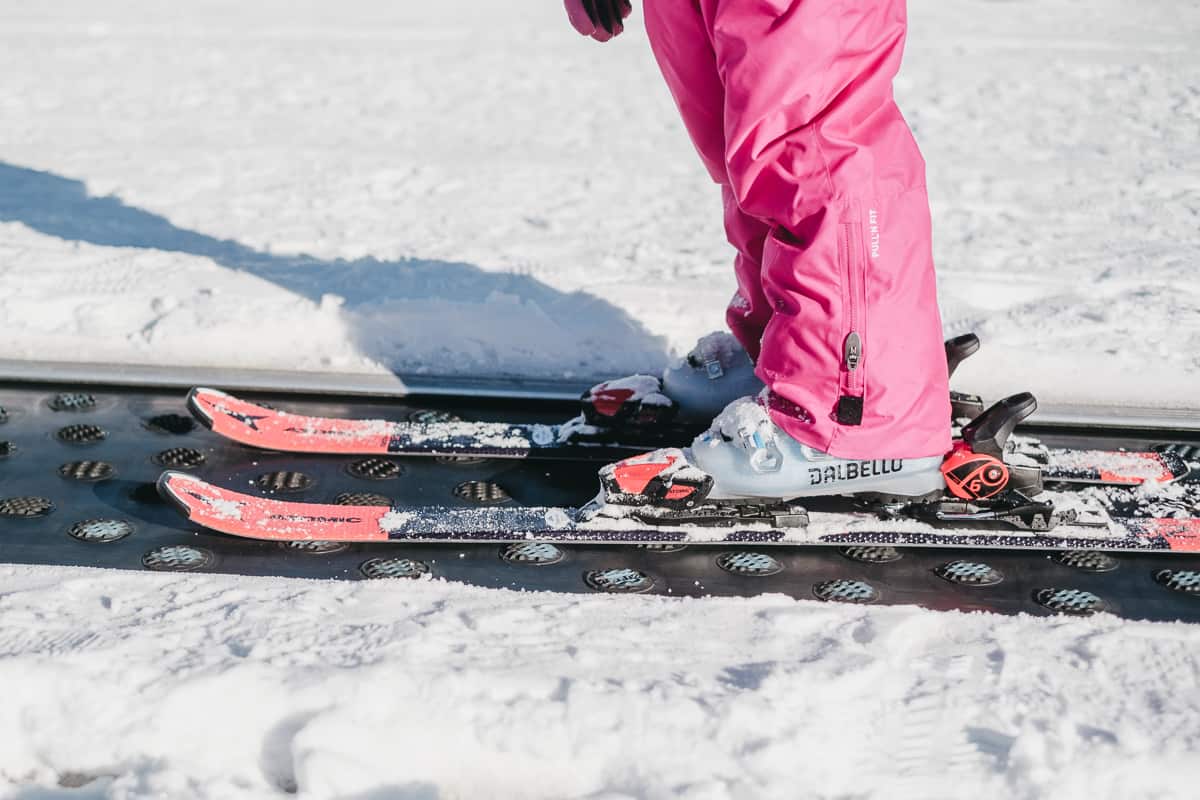
Choosing ski equipment for children
Now that we’ve covered clothing and whether to rent ski gear or buy it, let’s talk about how to choose the right ski gear for your little ones. Getting the right equipment for your kids will allow them to progress at the right level and have fun. You want to choose skis that are suitable for on-piste (on groomed marked trails) because that is where your child can easily learn and develop their skills. When you are choosing skis for your kids it is also important to select skis appropriate for their level of experience. For example, beginner skis will always be softer and more forgiving compared to advanced skis.
Skis for kids
Making sure your child is using the correct pair and size of skis for their size and ability will help them learn faster. As a rough guide, kids’ skis should come up to the child’s chin. Shorter skis are easier to turn. While it won’t make a difference to the ski’s performance, don’t underestimate the power of skis in a certain color/ with a certain graphic to get your child excited about skiing!
Ski poles for kids
Poles just get in the way when first learning to ski and should NOT be used at all until the child is comfortably turning and skiing parallel between turns. Once your child is comfortable on skis, poles can help with balance or quick turns. To make sure your poles are the right length, have your child stand in their ski boots and hold the poles. Their elbows should be at a 90-degree angle. Make sure the wrist strap is adjusted comfortably.
Ski boots for kids
The right fit in your child’s ski boots can make a big difference to their experience on skis. The most important thing is to get the correct size and boot type. Children’s ski boots are generally soft in flexibility (although, they can still be uncomfortable) and can have between 1 and 4 buckles. When trying on boots, wear ski socks for an accurate fit. You don’t want them to be too tight, but you also don’t want them to be too loose. Kids should be able to wiggle their toes with ease, but have a snug fit around the ankle for support.
Ski boots should ALWAYS be custom fitted to the bindings on the skis your child will be using. A ski technician will make adjustments according to the child’s size, weight, and ability. This is really important for the child’s safety when skiing. You want the binding to release under the right amount of force.
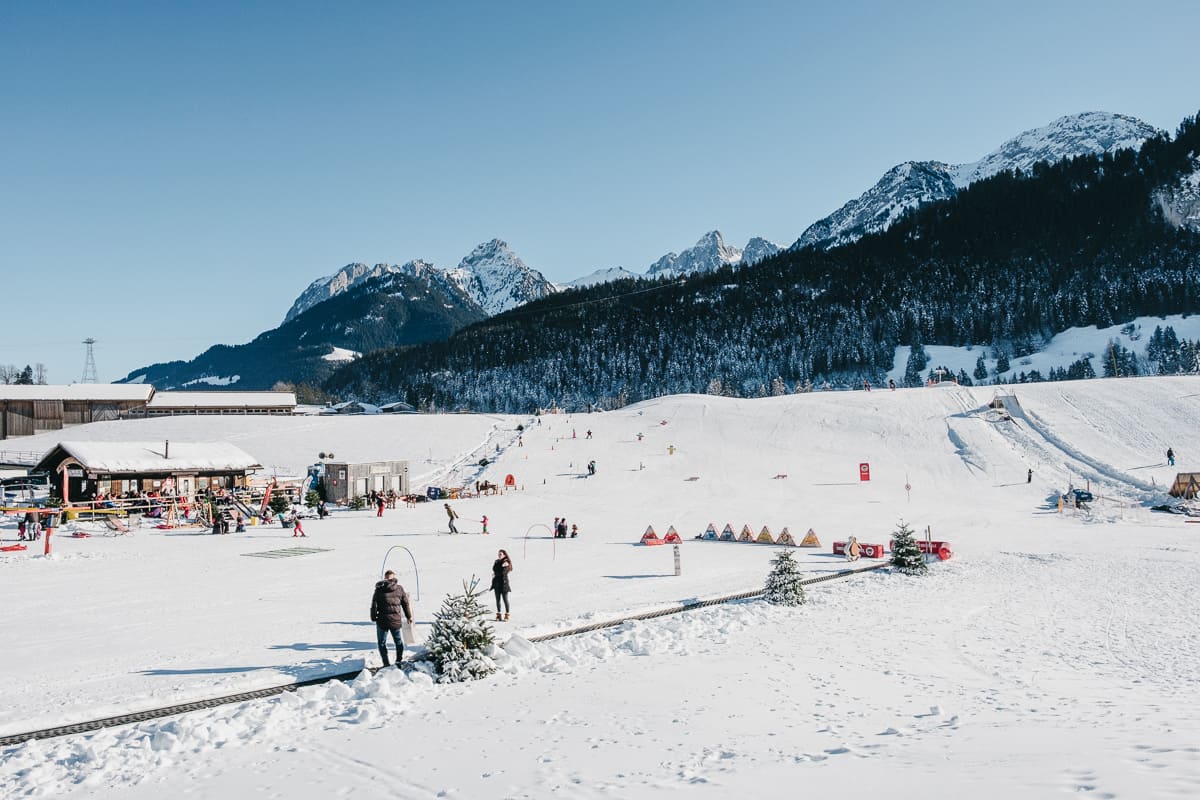
Choosing a child-friendly ski resort
When choosing the best ski resort for kids and families, there are many factors to take into consideration: cost, availability of lessons, ease of access to the slopes, the difficulty of runs, etc. Here are some of the things you may want to think about
Easy access to slopes
When beginning your search, you want to find one with easy access to the beginner area so that you don’t have to walk a long way. Skiing requires a LOT of gear and it can be very heavy to lug around. Plus, walking in ski boots is a challenge at the best of times, let alone when you’re carrying everything (including a kid). The closer you are to the slopes and the ski areas, the better! Ski-in/ski-out locations are ideal choices for families because they require so little transport time and logistics. If on-site lodging or slopeside access isn’t an option, take a peek at resort maps beforehand and figure out the best place to access the slopes, either from a specific parking lot or bus/shuttle route.
Difficulty of runs (kid-friendly areas)
When children are learning to downhill ski they need wide, flat, gentle slopes. Look for somewhere that gets the sun as this softens the snow for any tumbles and is just more pleasant overall. Sometimes an area will only be in the sun for part of the day. Often resorts will have specially marked nursery slopes (bunny hill) for beginners.
Dedicated learning zones specially designed for young children to learn to ski are even better. These areas often have magic carpets that the children can ride up the slope, avoiding the need to learn how to ride a lift. There are obstacles, inflatables, carousels and other props to make the experience interactive and fun. There may even be small jumps that are great for keeping more confident beginners interested while their younger siblings get started.
Longer slopes are also better as the child has more time to find their groove and link their turns together. Once your child’s ability level increases and they graduate from these learner zones, choose a wide, gentle slope to practice on.
Look for kid ski free programs
Cost is also a consideration when choosing where to ski. Often children under a certain age will be able to ski for free. Most major ski resort allows toddlers (and sometimes preschoolers) to ski free. Look closely at the age that a ski resort begins charging for lift tickets as this can start as early as 3 or 4 years old, but may not be until several years later (7 or 8).
Here in Switzerland, you pay a separate, small fee to use the children’s snow parks. This is far more economical than buying a day pass or lift tickets for the whole area. There is no point in buying a lift pass covering a large area for a child who is just learning to ski!
Crowds and lifts
The less crowded the ski resort, the better! No one likes waiting forever in lines or constantly feeling like you may ski into someone on the slopes. The less crowded a resort, the better. Consider smaller resorts or going on off-days (during the week).
Chair lifts can be intimidating for little ones just getting the hang of skiing. Cable car access is best as it takes away the stress of learning to use a chair life or a drag lift and gives the child a proper rest between runs.
Other resort amenities and activities
If you’re going to be at a ski resort for longer than just a weekend, be sure to check out what other activities and amenities are offered. Even if you have kids who love to ski, chances are they’re not going to ski all day, every day. Many resorts have really fun non-ski activities for kids, such as snow play centers, tubing, bowling alley, terrain park, movie theaters, ice skating rinks, snowmobiling, and more. Also, some resorts offer night skiing, which is a fun option that allows you to go explore other areas during the day.
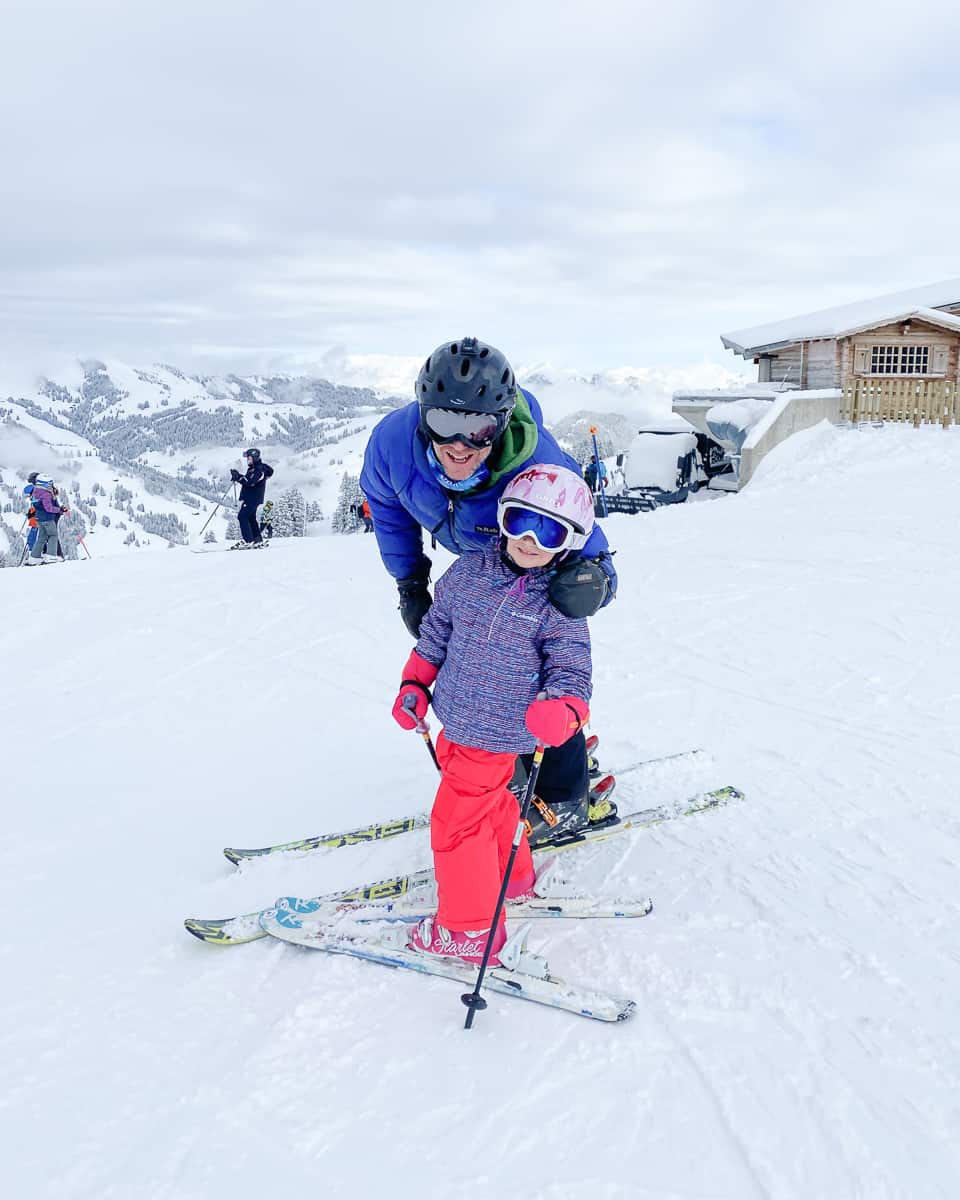
Teaching your kids skiing: should you do it yourself?
If you are a competent skier yourself, then teaching your child to ski yourself can be very rewarding! It’s also a very affordable option. However, oftentimes it’s not the parent’s skill that determines how successful they are at teaching their child, but how much patience they have! Parents that choose to teach their child to ski on their own has to forgo their own expectations (and their own day on the slopes) to help their little one. Our advice for teaching your child to ski is to really take it slow and try to remember it’s about having fun. And always take lots of photos! Here are a few more beginner pointers.
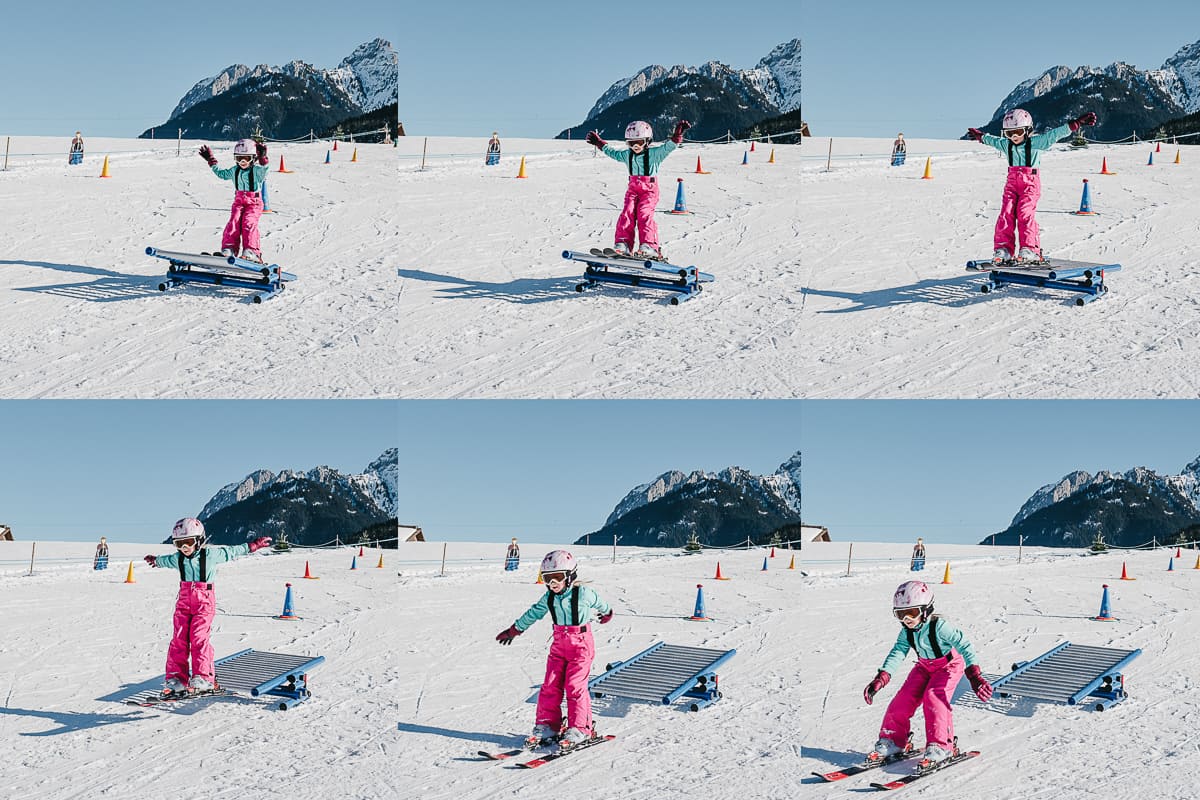
The basics of learning to ski
Have your child practice standing up by themselves in skis on snow first. This is not as easy as it sounds. For a little one on skis for the first time, this might take quite a while. There will be falling. There might be tears. But, it’s a skill that will be needed again and again.
Side-stepping and duck-walking come next, along with the all-important art of how to fall. Practicing this makes falling into less of a fail and more of a game.
Sliding comes next, along with learning to stop by making a pizza wedge shape with the front tips of the skis pointing towards each other. Once this is mastered then you can move on to snowplow turns.
Mastering turning will get kids skiing. Turning on skis happens from the feet, knees, and hips. Instead of telling kids to put their weight on one ski to initiate a turn, work on getting them to take an athletic stance and get skis on edge. Playing games like follow the leader are a great way to help children initiate turns.
If your child is confident linking turns and stopping, it’s time to hit the slopes!
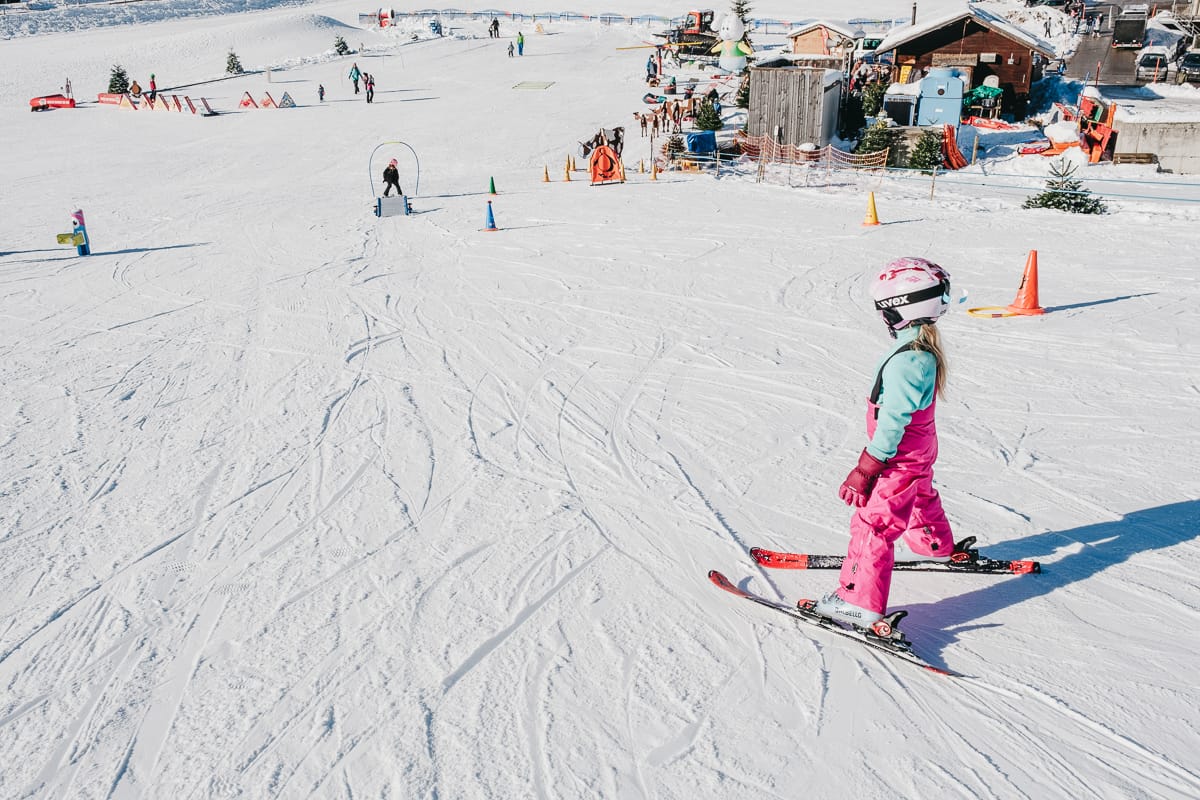
Training aids for kids learning to ski
There’s only really one training aid that I would really recommend and that is a ski tip connector. This is a little plastic or rubber device that clips the tips of the child’s skis together to make it easier for them to form, and hold, a snowplow. There are lots of different models – the Edgie Wedgie is a popular choice – but they all basically do the same thing and can be invaluable at the start. Inexpensive and easy to stuff in a pocket, they can be pulled out when needed to boost the child’s confidence, relieve tired legs or reduce falls due to skis crossing on top of one another.
Body harnesses and ski harness vests can be useful for very small children to pick them up when they fall or help them on and off lifts (they’re also good for cross-country skiing). However, for the most part, I would avoid using them with any kind of reins when downhill skiing. If a child’s speed needs to be checked with reins, then they are probably on a slope that’s too steep for them or need more practice at controlling their speed themselves.
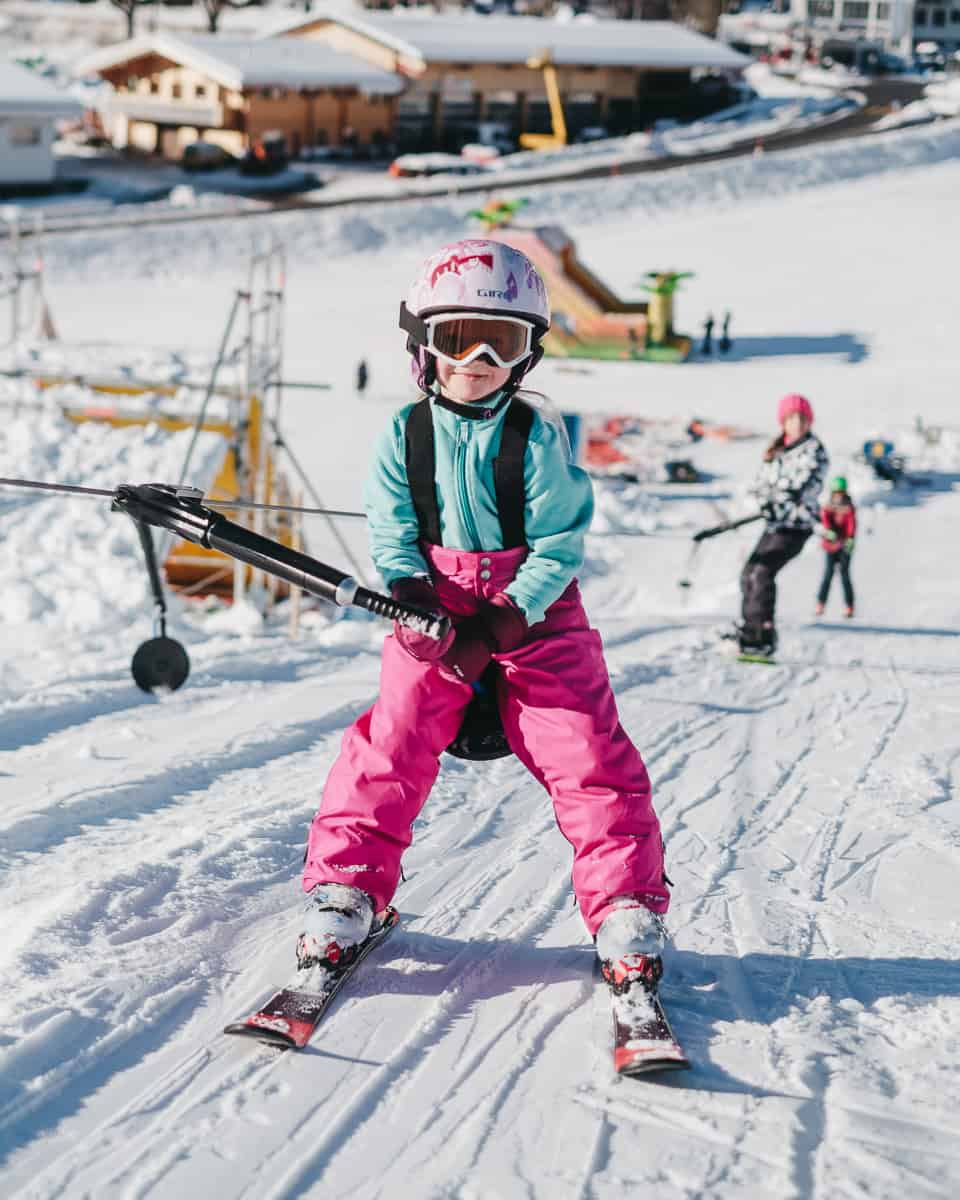
Ski schools or private lessons?
If you’re not up for teaching your child yourself (and there’s definitely no shame in that!), consider signing your child up for a lesson at the resort’s ski school or even a private lesson. Most major ski resorts offer ski schools for children, some are half-day and some are all day. The best all-day programs make plenty of time for learning and fun at an age-appropriate level. In between ski lessons, kids can take a break for snow play, tubing, hot chocolate breaks, lunch, and sometimes movies. Too much skiing can be exhausting for kids and result in frustration rather than skill improvement.
Enrolling your child in a group lesson with the local ski school has other advantages, too. They get to hang out with (and be motivated by!) other kids. Children’s ski instructors have lots of tricks up their sleeves to make lessons fun and the skills easy for them. Often – let’s be honest – kids listen to instruction a little better when it doesn’t come from mum or dad!
If you sign up for a week’s worth of lessons this often works out more economical, and there might even be a certificate or award for your child at the end. Whether your child will thrive or not in a group environment is often very personal. Neither of my rather shy kids wanted to join a group class when they were first learning, and so we didn’t push it.
One of the disadvantages of group lessons is that you will be tied to the schedule dictated by the ski school. Sometimes with little kids, simply getting them ready to join a 9 am lesson can be a challenge in itself! So what’s the alternative? Private lessons with a private ski instructor are great but can get pricy pretty quickly. That said, you may not need more than a couple before your child has grasped the basics, particularly if they are a little bit older.
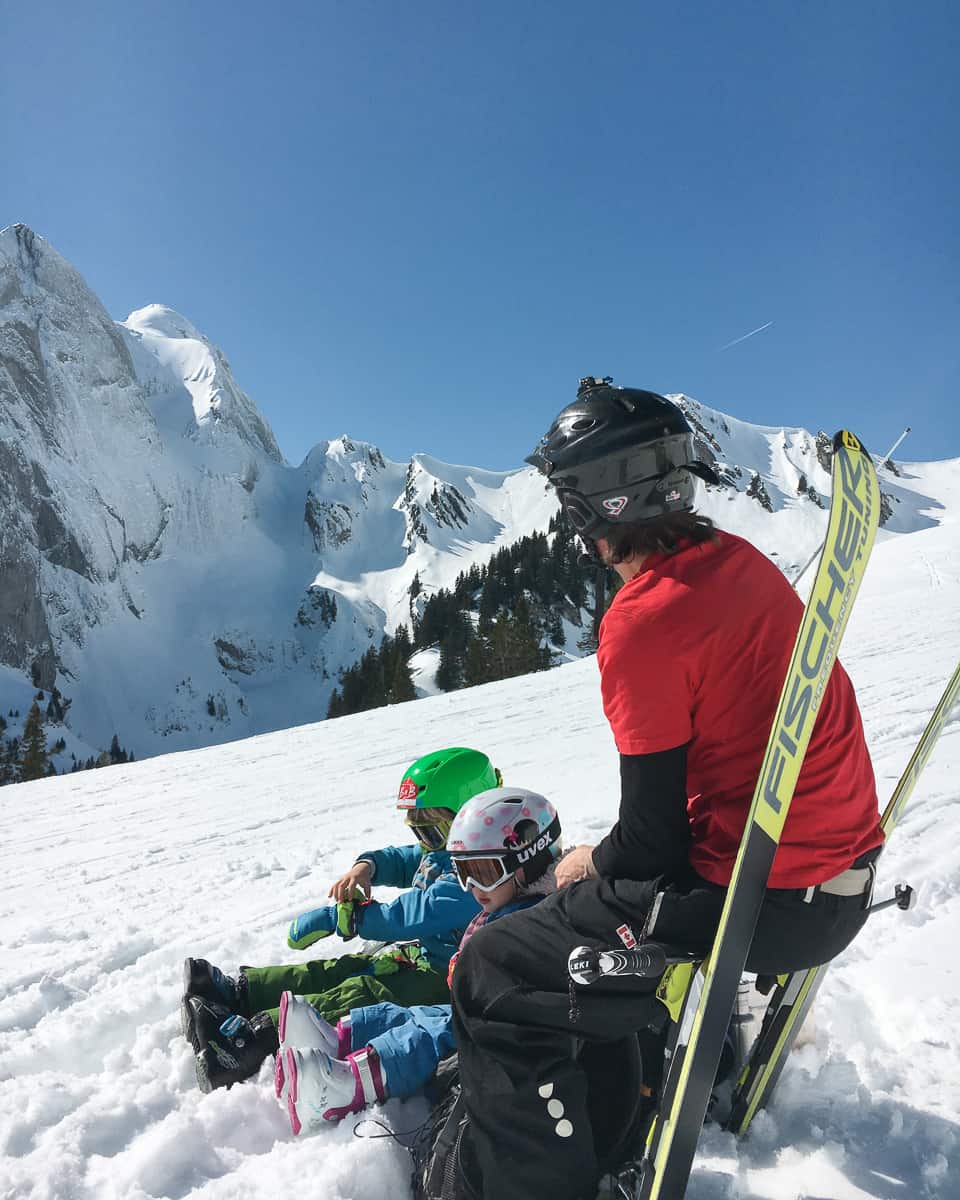
Top tips for skiing with kids
Well, we’ve covered a lot in this post! I hope you learned a few things about starting the journey of downhill skiing with your kids. Teaching a child to ski at first can sound daunting and intimidating, but skiing is such a fun and rewarding activity that the whole family can enjoy for years to come. It’s worth it. Here are my top tips for skiing with kids.
- Take lots of breaks! Being outside in the cold, learning something new… it’s a lot to take in especially for very young children. Alternate time on skis with time spent playing in the snow, stopping for a snack, or warming up in a restaurant.
- Pack a backpack with snacks, a flask/thermos of something (possibly warm) to drink, sunscreen, spare gloves and socks, tissues for runny noses, spare underwear or nappies, and an extra layer.
- Keep small treats handy in a pocket for when your kid needs a little extra motivation.
- If your child has long hair, tie it up and save yourself the trauma of combing out matted strands at the end of the day! I find one or two plaits/ braids work best.
- Finish on a high! As tempting as it is to push for one more run, children get overtired quickly. Stop while it’s still fun, treat them to a hot chocolate at the end of the day and have them eager to return.
My kids are now 6 and 8 and skiing has become one of our favourite things to do as a family. Being able to cruise all over a mountain on skis is an experience unlike any other and skiing is a skill they will now have for life! I wonder where it will take them?
Did you learn to ski as a child?
Are you considering learning as a family?
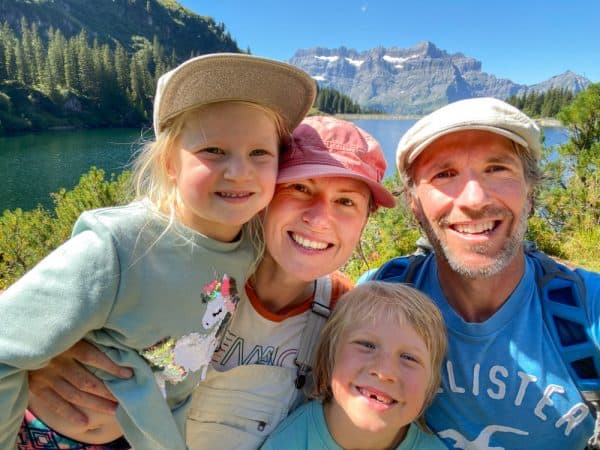
About the author
Sarah is originally from the UK but moved to Switzerland 14 years ago and never looked back! She lives with her Swiss partner and 2 children, aged 8 and 5, in a beautiful corner of the Swiss Alps. Together they run a large chalet and are kept busy looking after the groups and guests that stay there. Sarah enjoys anything that gets herself and her family out into nature. Skiing, hiking, and paddling on local lakes are favourite family activities, and annual camper van trips are always highlights of the year. Hugely inspired by the landscapes around her, she loves nothing more than taking her camera along to photograph or film their adventures and capture all the beautiful details of the natural world around them.
Find Sarah online in the following locations:
Instagram: @swissmountainlife
Website: www.sarahbach.ch
Chalet: @bnbvieuxchalet
More RWMC posts from Sarah: Sarah Warburton
Comments
5 responses to “Beginner’s Guide to Downhill Skiing with Kids”
Such nice ideas.. you have written it so well. Love this post!
[…] Here’s a great post with the best tips for getting started downhill skiing with kids. […]
[…] downhill skiing, cross-country skiing involves gliding across relatively flat terrain, relying on your own power […]
[…] Next winter, why not try cross-country skiing or downhill skiing? […]
[…] the fun the winter has to offer. If your kids are new to skiing, we highly recommend you read our beginner’s guide to downhill skiing with kids. Or get the kids a lesson or ski school before hitting the slopes. Instructors are usually really […]

Leave a Reply